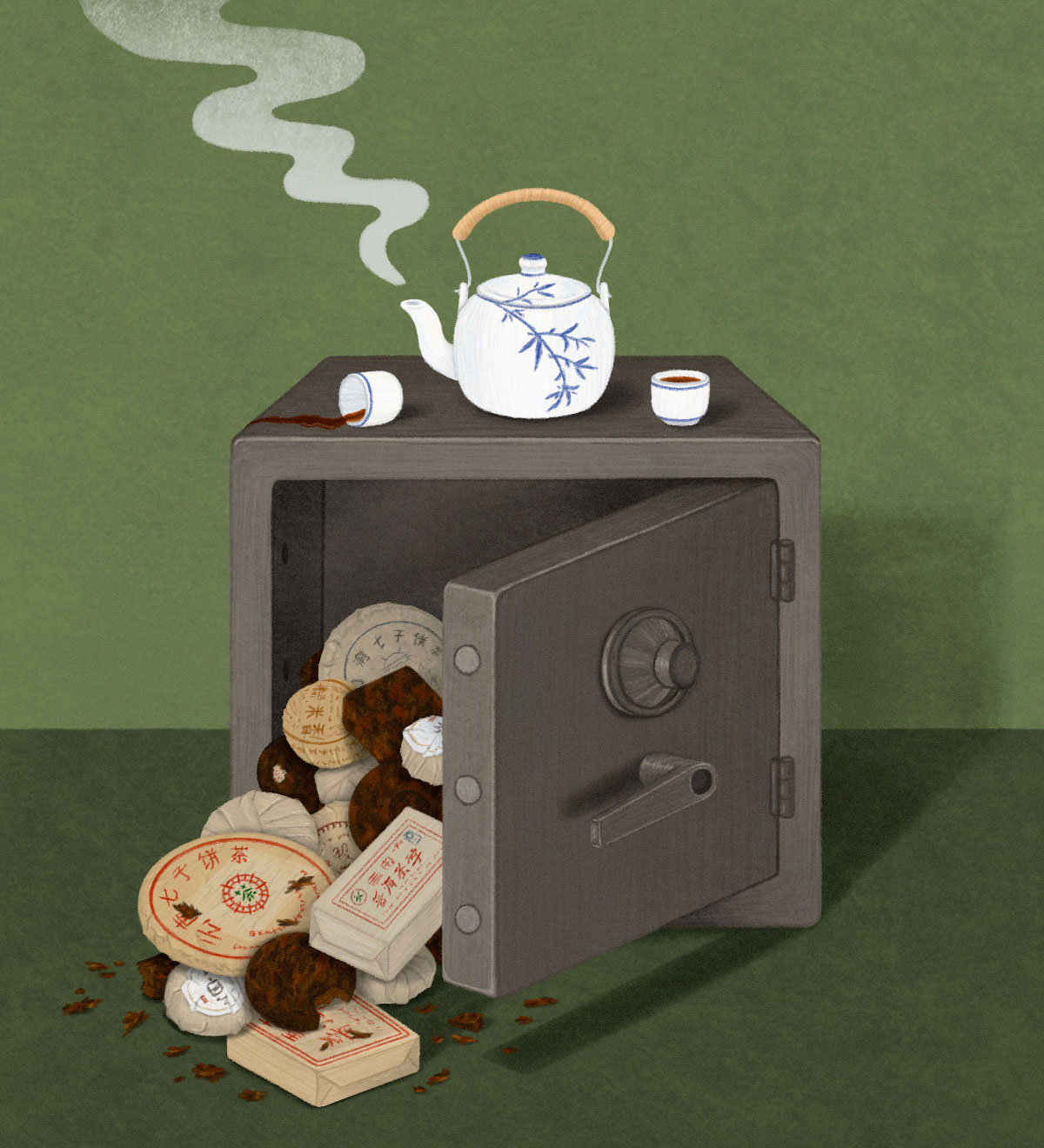On June 3, 2007, a 6.4 magnitude earthquake rocked China’s Yunnan province. The quake killed three, injured hundreds, and left behind property damage worth billions of yuan. It was a tragic setback for Yunnan’s largely rural counties that had been enjoying an economic boom as the seat of China’s pu-erh tea industry. For the preceding decade, sales in pu-erh tea had surged, and those sales were about to be scrutinized.
When news of the earthquake reached Guangzhou’s Fangcun tea market—one of the largest in China and almost a quasi–stock market for the tea trade—something impossible happened: the going price of pu-erh tea remained the same. This contradicted bedrock economics. The earthquake had damaged tea factories and infrastructure, so the price of pu-erh tea should have gone up to reflect the lowered supply. And if it wasn’t going up, that had to mean someone in the commercial chain had untethered tea prices from reality.
Buyers, sellers, and traders wanted answers. Outsiders may well have asked another question: How did a tea, of all things, become the target of market manipulation?
Pu-erh tea—a fermented variety typically compressed into a brick or disk, sometimes called a cake—gets its name from the historic Yunnanese market town of Pu-erh, now named Ning-er. The southwestern province, verdant and mountainous, contains more than 40 percent of China’s rare and endangered plant life. Part of that diversity is the tea plant Camellia sinensis. The mountains of Yunnan hold the most ancient Camellia sinensis varietals in the world and, at 3,000 years and counting, according to estimates, some of the oldest tea trees on Earth. Unlike carefully bred and barbered plantation teas found elsewhere, used to produce varieties such as Darjeeling or Assam, wild “da ye,” or big-leaf, teas are bitter, astringent, and smoky.
According to legend, that burly flavour was tamed through an alchemical quirk discovered by accident: after merchants compressed wild tea leaves into bricks and cakes for easier transportation, the months-long trips on caravans travelling the “tea horse road” across China and Central Asia fermented the leaves, mellowing and enhancing their taste. That fermentation also improved with time. Like with wine, the longer a cake of pu-erh fermented under the right conditions, the more complex and flavourful it became.
Until the 1990s, aged pu-erh was a blip on the modern tea connoisseur’s radar. Compared with perennially esteemed teas like Big Red Robe oolong or Dragon Well green tea, pu-erh was valued primarily as a stomach-settling accompaniment to fatty dim sum dishes. Accordingly, it was cheap, valued at approximately 10 yuan—or $1.38 (US), based on current exchange rates—per kilogram in 1992. Things began to change when wealthy tea enthusiasts from Taiwan arrived in Yunnan with a taste for naturally aged pu-erh tea and the drive—and cash—needed to energize the then quiet local tea scene. In 2004, the price of pu-erh went vertical.
Lawrence Zhang, an associate professor of history at the Hong Kong University of Science and Technology and author of the blog A Tea Addict’s Journal, explains that a roaring Chinese economy in the early 2000s unlocked a massive reserve of customers willing to pay higher prices for non-essential goods. In that vein, pu-erh prices rose alongside those of goods like traditional alcohol. The rising prices attracted speculators, who began to buy the tea in bulk—not for consumption but for resale.
Pu-erh’s packaging and aging potential make for a desirable asset vehicle: after compressing the dried tea leaves into cakes, factories embed a descriptive ticket into each pressing and wrap each cake with thick paper detailing the tea. Tickets and wrappers are tracked in manufacturer yearbooks, making it easy to identify the provenance of cakes, which therefore have a standard reference for reselling. Compared to a jar of unmarked green tea that would go stale in a year, cakes of pu-erh are practically company stock. Because factories charicteristically stack seven cakes into cylinders, called tongs, which are in turn packaged in a carton known as a jian, buying in bulk adds additional authentication, and therefore value, to the tea.
In Pu-erh Tea: Ancient Caravans and Urban Chic, author Jinhong Zhang describes a massive national focus on tea; between 2005 and 2006, the number of pu-erh-specific shops across China tripled. Would-be farmers bought land attempting to cultivate their own trees. Would-be investors entered the market. As pu-erh prices rose, the heights they seemed capable of reaching stretched higher as well. At least until 2007.
In the aftermath of the earthquake, CCTV investigations revealed why the price of the tea hadn’t risen: speculators had been hoarding pu-erh, creating false scarcity in the market in order to drive prices higher. As much as 95 percent of the tea traded at the Fangcun tea market had been purchased not for drinking but for storing as an investment. Now that the true supply had been revealed, the market cooled. The value of pu-erh, according to Zhang, dropped by half—a collapse that affected hundreds of farmers, sellers, and investors in China, Taiwan, and Hong Kong, many of whom went bankrupt.
Far from abandoning pu-erh as a tulip craze, die-hard speculators still believe there’s money in the tea market. Even after the price of pu-erh popped in 2007, many cakes continued to appreciate in value. An unremarkable Dayi 7542, for example, purchased for roughly $25 (US) after the market crash in 2008 could have fetched $55 in 2021, when the price of that cake peaked—an increase in value roughly comparable to a mutual fund’s performance over the same period. And some tea blends, like the Dayi 801 Gaoshan Yunxiang recipe, which sold for around $25 (US) per cake in 2008, reached a peak of $1,006 in 2023—a 3,924 percent return on investment. Investors purchasing a carton of these cakes in 2008, and selling at the right time, could have made a down payment on a Toronto townhouse. Today, some pu-erh from the larger producers is traded with real-time tickers showing the fluctuating price of a cake and the value growth over time—a bit like an unregulated New York Stock Exchange. There’s even trade in pu-erh futures: offerings to purchase tea for the coming year’s harvest.
Critics say the pu-erh game is too much of a Wild West for investing: a cake might simply not gain value, or poor market timing could swallow the investment, or the investor might just fall prey to outright fraud. The pu-erh market is a tempting space for forgers, who will disguise cakes from less-famous regions in premium packaging, or artificially fermented ones in older wrappers. Literal tonnes of suspicious tea have been confiscated and destroyed by authorities in China. Regardless of forgeries, fraud still abounds: in 2023, a financial scam built around pu-erh futures was unearthed at Fangcun.
Zhang, at the Hong Kong University of Science and Technology, breaks down post-2007 pu-erh investment into two primary markets. The first is already-expensive pu-erh: cakes packaged before 2000. Due to a dwindling supply, these are likely to continue appreciating. Last year, a single cake from the 1950s sold in a Sotheby’s auction for $71,600 (US). The second market is modern pu-erh. While these teas tend to be cheaper, the right hype can elevate their value. Some enthusiasts enter this camp accidentally, by simply purchasing more than they can drink, then turn into resellers to further fund their hobby.
There is no way to gauge how many serious tea investors are in the market today—or to quantify how many are simply enthusiasts who occasionally resell and how many are sharks hoping to get rich. But recent factory outputs hint that producers expect most of their buyers are investors rather than consumers. Factories are slipping holographic ribbons onto their labels, releasing special editions and limited runs, and kicking resellers off e-commerce sites like Taobao, ostensibly to prevent fraud but with the inevitable benefit of controlling prices. The sum of these actions sells the hope of appreciation as well as the risks of depreciation to collectors and secondary buyers—like me.
I first tasted pu-erh in 2016, brewing the crumbling edge of what had once been a larger cake, now unidentifiable, in a French press in my parents’ kitchen. The first sip tasted like licking honey off a bison, the second like dates scraped off a mahogany table. Sweet fruit. Animal. Tobacco. Fall leaves. I needed more. Unfortunately, coming out of graduate school, I was far from cash rich. I figured that if I just bought cheap, modern cakes, they would eventually mature into fine pu-erh. Anything I didn’t drink, I could sell.
But even storing pu-erh in my parents’ house at the time was rife with investment risk. The ideal conditions for aging pu-erh rely on a healthy environment for the bacterial strains that facilitate aging. In China, this has traditionally taken place in southern warehouses, where the relative humidity hovers in the nineties and the temperature soars. Even in cool and dry storage environments like those in Yunnan, the relative humidity is higher than that of many North American settings. This hasn’t stopped collectors and resellers from fashioning so-called pumidors from unplugged refrigerators, clay jars, or Tupperware, but with results that can vary based on the attentiveness of the owner. While I diligently watered my pu-erh for a year to keep humidity high, throwing different humidification methods at my cakes week after week, I eventually became bored, busy, and employed. After two years, I abandoned my pu-erh stockpile as well as hopes of making back my money.
James Schergen, host of the TeaDB YouTube channel, is often asked about the viability of investing in pu-erh. In the West, he says, it makes little sense to bank on the tea. Instead, “you buy the tea because you like it and you’re not sure if it’s going to be available in the future,” he says, “and maybe you buy it at ten years old to see what it’ll taste like at twenty years.” He suspects that some of the interest might come from some distrust of traditional financial institutions, but the main driver is probably a newcomer’s enthusiasm for the hobby. Schergen generally advises focusing on learning about and enjoying the tea itself rather than becoming fixated on the ups and downs of a price ticker.
Lawrence Zhang knows people who used to drink pu-erh casually before it became a precious commodity—who felt uneasy about brewing it after prices rose. Even though they’d bought it for a reasonable price, drinking it began to feel like throwing money away.
For anyone who loves pu-erh, there is something magical about prying apart a cake. Leaves that once reached to touch the sun are exposed to light and allowed to breathe again. And as they’re unfurled by hot water, they release their aromas—alongside the invisible efforts of farmers and pickers, factory workers and pressers, sellers and resellers, as well as stories of rivers and lakes, of long-travelled roads and the chatter of friends and family. Surely, that’s worth something.




